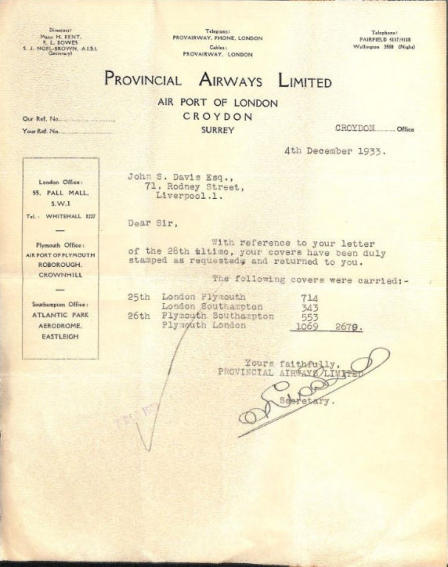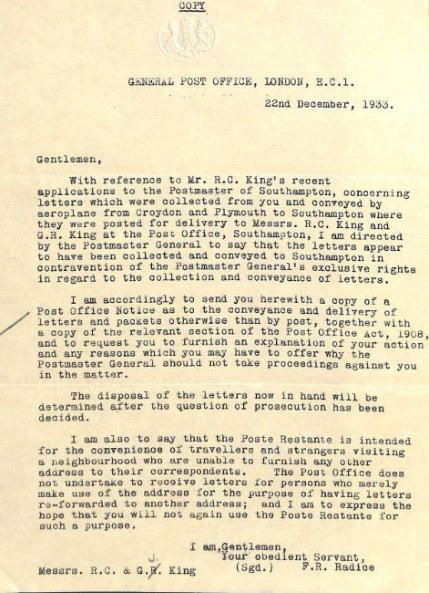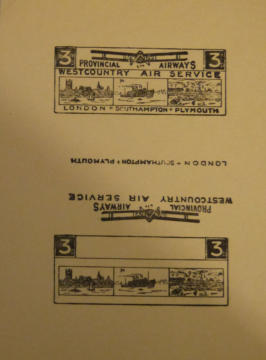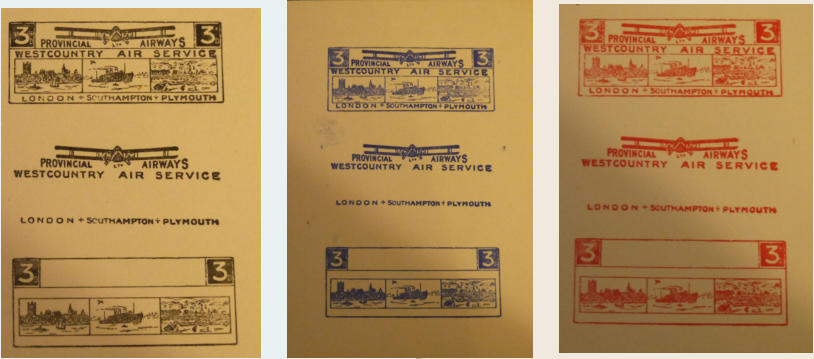
Provincial Airways - Letters
Copyright
© 2022 Robert Farquharson All Rights Reserved

British Internal Airmails of the 1930’s
Included below is a selection of letters sent to Provincial Airways or from Provincial Airways mainly about the flights of the
25th and 26th November. Also included are letters sent from the Post Office on behalf of the Postmaster General about
abuse of Poste Restante facilities and abuse of the Postmaster Generals monopoly on the delivery of mail.

The invoice sent out by Provincial Airways Number 1001. First letter noted after the inauguration of the company on the 12th October. It is an
invoice to the Newport Airmail dealers A. Phillips for 900 covers and 100 separate stamps. This shows the large quantities that these dealers
were sending out.

Tressillian Bowmore was the Plymouth manager for
International Airlines and an ex RAF pilot although
there is no evidence that he flew for either
International or Provincial. This is the only letter
located by him and the only letter located from
Plymouth. The letter has a number of points of
interest. Firstly, Bowmore tells King that they do not
have a Post-office contract. This indicates they were
well aware of the post office rules on the carrying of
mail. If the Postmaster General had seen this letter,
he may not have been so lenient after their mail
flight. Secondly, Without the whole sheet it is
impossible to tell the printing of the air stamp, but
this is first or second printing. It is interesting that the
air stamps had been printed for at least the first
printing only eighteen days after inauguration. Clearly
an air mail flight was at the forefront of their thinking.
Thirdly, Bowmore says the Great Western air service
was suspended for the Winter. This affirms that there
was no intention of running a scheduled service
during the Winter. Fourthly, he said he encloses a
timetable, presumably this is for the Summer service
which started on March 19th, 1934. The fact they did
not know when the service would restart meant it
would have been a general timetable.

VERY IMPORTANT LETTER
This letter confirms that the flight of the 25th/26th
November 1933. was a mail only flight and not part of a
scheduled service. This shows beyond doubt that the
previous accounts of this flight was not correct, it was
not part of a regular service, it was a pure philatelic flight
to generate ‘First flight’ covers for dealers and collectors.


These two letters show the number of covers flown. The first letter sent on the 4th of December only included four of the six routes. The second letter of
the 30th of December shows the number of covers flown on the other two routes. The second letter confirms the pilot was S. W. A. Scott, the
International Airlines pilot who later become chief pilot with Provincial Airways when it ran a scheduled service in 1934 and 1935. It also gives the
registration of the plane as G-EBZP. It was previously thought that the plane used was a new DH 80 moth which the airline had bought. G-AEBZP was a
De Havilland 60 which was a two-seater tourer. Although a much smaller aircraft the covers only numbered just over 3000 which could comfortably be
stored in the passenger seat. It does confirm though that there was no intention of carrying passengers and this was mail only. Another interesting point
is that the plane was never registered to Provincial Airlines so it must have been hired for the event.
The Postmaster General Responds
Historic literature on this flight gives the impression or sometimes clearly states that the carrying of mail was stopped because of the intervention of the Postmaster General. We have already seen that this was a special flight for the carrying of first flight covers. No other flights were planned (they would not be first flights anymore). We see below four letters from the Post Office on behalf of the Postmaster General. The first is not till the 22nd of December, so clearly the PGs intervention had nothing to do with no further flights being organised. As we will see further down, Provincial from the end of January made it clear to correspondents that were not allowed to fly mail. A number of points arise from the letters below. Firstly, the Postmaster General got involved because the dealer George King abused the Poste Restante service. If he had not done this, the PG may never have known about the flights. Dealers often abused the Poste Restante service, but clearly not to the extent that George King did here. It was a common ploy to send first flights covers to remote destinations ‘Poste Restante’ and then write on the back. ‘If not collected within four days, please return to ….’. This way they would not have to collect the letters and the Post Office would have the expense of sending them to the dealer’s address. They got away with it for a few covers, but as can be seen George King sent far too many by this method. Secondly, the first letter is quite hardnosed. The PG is threatening Provincial with prosecution and threatening to destroy George King’s covers. They later softened their stance. Thirdly, the second letter maintains a hard stance and demands an explanation of Provincials actions. Unfortunately, we only have one side of the correspondence at present. I had hoped to find the other side at the Postal Archives, but this is presently closed. Hopefully in the future these letters can be matched. Fourthly, the PG has softened his stance and is now merely asking for assurances that there will be no reoccurrence of these flights. Fifthly, although we do not have the corresponding letters it is clear that Provincial have pleaded ignorance of the regulations and even has the cheek to suggest the Post Office didn’t properly advertise the situation. We know from the letter at this at the top of this page that this is not the case. Provincial knew exactly what they were doing but managed to convince the PG that this was not the case. It would be interesting to see Provincial’s letter as the reference to Railway letters is interesting. They may have seen GWR’s continuing use of a 3d air letter service and wondered why they were treated differently. The answer is that GWR asked the PG whether Railway letters applied to them as an airline, as they were a railway. He affirmed on the 27th of April 1933 that this was the case. It would not apply to Provincial as they were not a Railway. A bit unfair, but those were the rules.

Letter 1 - 22nd December 1933
Letter 2 - 04th January 1934

Letter 3 - 18th January 1934

Letter 4 - 25th January 1934
Other Letters

Invoice from Provincial to A. Phillips. Note the large number of air stamps
sold long after the flights had stopped. Also note the proviso that they are
sold with the knowledge that no further mail carrying flights will take place.


Letters written by pilot S. W. A. Scott sending signed covers of the flight on the 18th Sep and 25th Oct 1934

Provincial Airways - Letters
Provincial Airways - Introduction and Air Label
Provincial AIrlines was incoroporated on October 12th 1933 with assets of £10,000. It took over the mantle of International Airlines and may have inherited some of the personnel. They flew a ‘proving’ flight from Croydon to Southampton and Plymouth on the 25th November and returned from Plymouth to Southampton to Croydon the next day on the 26th, although the flight had to land at Heston due to bad weather at Croydon. These flights are disucssed further below. There was no further flights until the 19th March 1934 when the service properly started. Additional stops were added and more were added later in the year and in 1935. In 1935 Haldon was replaced with Provincial’s own aerodrome at Denberry. Despite the extra stops the airline was not viable and closed on 23rd September 1935 and went into liquidation on December 10th 1935. A fellow operator at Croydon, Air Dispatch took over the route in 1936 with no more success. Denberry was abandoned until becoming a wartime military camp and later Channings Wood prison.
Copyright
© 2020 Robert Farquharson All Rights Reserved



British Internal Airmails of the 1930’s














































